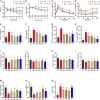Hypoglycemic Effects of Lycium barbarum Polysaccharide in Type 2 Diabetes Mellitus Mice via Modulating Gut Microbiota
- PMID: 35845787
- PMCID: PMC9280299
- DOI: 10.3389/fnut.2022.916271
Hypoglycemic Effects of Lycium barbarum Polysaccharide in Type 2 Diabetes Mellitus Mice via Modulating Gut Microbiota
Abstract
This study aims to explore the molecular mechanisms of Lycium barbarum polysaccharide (LBP) in alleviating type 2 diabetes through intestinal flora modulation. A high-fat diet (HFD) combined with streptozotocin (STZ) was applied to create a diabetic model. The results indicated that LBP effectively alleviated the symptoms of hyperglycemia, hyperlipidemia, and insulin resistance in diabetic mice. A high dosage of LBP exerted better hypoglycemic effects than low and medium dosages. In diabetic mice, LBP significantly boosted the activities of CAT, SOD, and GSH-Px and reduced inflammation. The analysis of 16S rDNA disclosed that LBP notably improved the composition of intestinal flora, increasing the relative abundance of Bacteroides, Ruminococcaceae_UCG-014, Intestinimonas, Mucispirillum, Ruminococcaceae_UCG-009 and decreasing the relative abundance of Allobaculum, Dubosiella, Romboutsia. LBP significantly improved the production of short-chain fatty acids (SCFAs) in diabetic mice, which corresponded to the increase in the beneficial genus. According to Spearman's correlation analysis, Cetobacterium, Streptococcus, Ralstonia. Cetobacterium, Ruminiclostridium, and Bifidobacterium correlated positively with insulin, whereas Cetobacterium, Millionella, Clostridium_sensu_stricto_1, Streptococcus, and Ruminococcaceae_UCG_009 correlated negatively with HOMA-IR, HDL-C, ALT, AST, TC, and lipopolysaccharide (LPS). These findings suggested that the mentioned genus may be beneficial to diabetic mice's hypoglycemia and hypolipidemia. The up-regulation of peptide YY (PYY), glucagon-like peptide-1 (GLP-1), and insulin were remarkably reversed by LBP in diabetic mice. The real-time PCR (RT-PCR) analysis illustrated that LBP distinctly regulated the glucose metabolism of diabetic mice by activating the IRS/PI3K/Akt signal pathway. These results indicated that LBP effectively alleviated the hyperglycemia and hyperlipidemia of diabetic mice by modulating intestinal flora.
Keywords: Lycium barbarum polysaccharide; gut microbiota; hypoglycemia; hypolipidemia; type 2 diabetes mellieus.
Copyright © 2022 Ma, Zhai, Xie, Chen, Zhang, Liu, Nie, Yuan, Tu, Tian, Zhang, Chen and Li.
Conflict of interest statement
The authors declare that the research was conducted in the absence of any commercial or financial relationships that could be construed as a potential conflict of interest.
Figures









Similar articles
-
Lycium barbarum Polysaccharide Regulates the Lipid Metabolism and Alters Gut Microbiota in High-Fat Diet Induced Obese Mice.Int J Environ Res Public Health. 2022 Sep 24;19(19):12093. doi: 10.3390/ijerph191912093. Int J Environ Res Public Health. 2022. PMID: 36231391 Free PMC article.
-
Serum metabolomics combined with 16S rRNA sequencing to reveal the effects of Lycium barbarum polysaccharide on host metabolism and gut microbiota.Food Res Int. 2023 Mar;165:112563. doi: 10.1016/j.foodres.2023.112563. Epub 2023 Feb 3. Food Res Int. 2023. PMID: 36869545
-
A homogeneous polysaccharide from Lycium barbarum: Structural characterizations, anti-obesity effects and impacts on gut microbiota.Int J Biol Macromol. 2021 Jul 31;183:2074-2087. doi: 10.1016/j.ijbiomac.2021.05.209. Epub 2021 Jun 8. Int J Biol Macromol. 2021. PMID: 34097961
-
Effect of Lycium barbarum polysaccharides on cell signal transduction pathways.Biomed Pharmacother. 2022 Mar;147:112620. doi: 10.1016/j.biopha.2022.112620. Epub 2022 Jan 12. Biomed Pharmacother. 2022. PMID: 35032768 Review.
-
Yeast Synthetic Biology for the Production of Lycium barbarum Polysaccharides.Molecules. 2021 Mar 15;26(6):1641. doi: 10.3390/molecules26061641. Molecules. 2021. PMID: 33804230 Free PMC article. Review.
Cited by
-
A dataset of branched fatty acid esters of hydroxy fatty acids diversity in foods.Sci Data. 2023 Nov 10;10(1):790. doi: 10.1038/s41597-023-02712-z. Sci Data. 2023. PMID: 37949921 Free PMC article.
-
Microbiome-Metabolomic Analysis Reveals Beneficial Effects of Dietary Kelp Resistant Starch on Intestinal Functions of Hybrid Snakeheads (Channa maculata ♀ × Channa argus ♂).Antioxidants (Basel). 2023 Aug 18;12(8):1631. doi: 10.3390/antiox12081631. Antioxidants (Basel). 2023. PMID: 37627626 Free PMC article.
-
Metallothionein-Kidney Bean Polyphenol Complexes Showed Antidiabetic Activity in Type 2 Diabetic Rats by Improving Insulin Resistance and Regulating Gut Microbiota.Foods. 2023 Aug 21;12(16):3139. doi: 10.3390/foods12163139. Foods. 2023. PMID: 37628138 Free PMC article.
-
Association between gut microbiota and malignant cardiac tumors: A two-sample Mendelian randomization study.Cancer Med. 2024 Jul;13(13):e7455. doi: 10.1002/cam4.7455. Cancer Med. 2024. PMID: 38953300 Free PMC article.
-
Developments in the study of Chinese herbal medicine's assessment index and action mechanism for diabetes mellitus.Animal Model Exp Med. 2024 Aug;7(4):433-443. doi: 10.1002/ame2.12455. Epub 2024 Jul 7. Animal Model Exp Med. 2024. PMID: 38973219 Free PMC article. Review.
References
LinkOut - more resources
Full Text Sources
Miscellaneous

